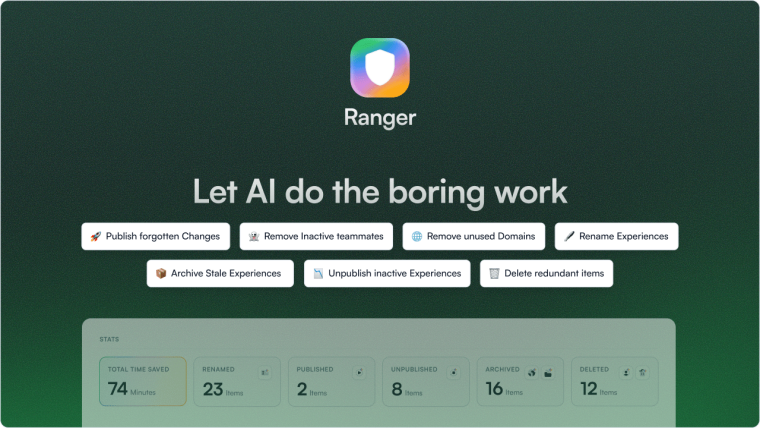The year was 2013. The all-new iPhone 5 had just hit the stores. Binge-watching was coming to the scene far too quickly. “Selfie” just landed in our dictionaries, literally.
Trends from 10 years ago are old news today. Yet, they were once the instruments of change, disrupting the status quo. And, if a trend is powerful enough, it might just become the status quo—like social media becoming an inseparable part of our lives.
In product management, trends can either shake things up for a short span, as it happened with Spotify squads, or produce long-term transformation, like Agile methodology.
Let’s discover insights from product leaders on the game-changing trends and get into more changes likely to disrupt the industry.
With product leaders from Productboard, Amplitude, and User Interviews, we discussed the most prominent trends that PMs should keep an eye on in 2025 and beyond
The top 3 trends that experts recognized include the increasing importance of retention, a broader role for PMs, and different PLG flavors to choose from.
What else is there? We've captured 5 more emerging trends happening in the world of product management, and we break them down below.
Top 3 product management trends explained by product leaders
We recently hosted a Leadership Roundtable with Pulkit Agrawal, Co-Founder and CEO of Chameleon, Srinivas Krishnamurti (SK), former-SVP Product at Productboard, Carol Guest, Director of Product Management at User Interviews, and Ibrahim Bashir, VP of Product at Amplitude, to talk about the most promising product trends and tactics for 2023.
Let’s break down their insights and take a deeper look at the three key trends for product teams.

Trend #1: Retention is the new black
There’s a bigger emphasis on retention than ever before. One of the most effective ways for product companies to accelerate growth and boost their bottom line is by scaling from within.
Zero in on your existing customers to become more closely aligned with their needs and identify ways to help them succeed. Product managers have to be crystal clear about what value looks like to their users (cue: with Microsurveys) and reassess their products’ capabilities to deliver that value quickly.
There’s a growing need for innovation and strategic thinking to continue to tie your product roadmap to high-ROI objectives and deepen your product-market fit.
While many product managers rely on their evergreen knowledge of customer expectations, they have to refresh this understanding to stay on top of how customer needs have evolved—do customers still care about the same aspects as they did when they first signed up for your product? It's also critical to check whether your product still fits these changing expectations and solves evolving pain points.
This emphasis on customer retention goes against the more popular idea of "growth at all costs.” In the past, this notion drove companies off track and led to a misplaced understanding of their ICP. An increased emphasis on retention is taking PMs back to the fundamentals to accurately figure out their ICP, identify growth levers, and stabilize a customer base against economic shifts–like the 2023 recession.
Ibrahim Bashir, VP of Product at Amplitude, explained this transition to the fundamentals as an attempt to slow down product development.

I think there’s a little bit of a measure-twice-cut-once situation going on. You could see it as slowing down product development or you could also see it as spending more upfront time and less pressure on success and support teams to deal with the implications.
Another crucial factor for product and growth managers is to be aware of their executive team's outlook on the market and customer retention. This alignment is important to ensure PMs work toward customer-centric, data-backed, goals rather than chasing the gut instincts of leadership teams.
Trend #2: The PM role is getting broader
The product manager role now goes beyond the traditional responsibilities of planning and managing product roadmaps. Now, PMs are required to think more broadly beyond just the product.
In 2023, PMs are responsible for all the moving parts in delivering a seamless customer experience: market research, user experience design, working with cross-functional teams, data-driven decision-making, and so much more.
So, how can product managers embrace these growing responsibilities and set their teams up for success?
Here are the actionable tips from product leaders:
Commit time to learn: Finding ways to continuously learn and upskill is critical. Dedicate 10-20% of your time to learning about emerging trends and new concepts.
Selectively choose resources: Be selective with the people you follow and the content you consume. Prioritize context over popularity to pick the five best learning resources best aligned with your product aspirations.
Unlock company knowledge: Look at the vital knowledge trapped inside your team. Design internal, knowledge-sharing avenues—like workshops, discussions, documentation, and more—to distribute your knowledge better.
Document your problem-solving approach: Create a running log of how you approached a problem in real time, then revisit your log later to gain a better perspective. Documenting your learnings—from project planning or customer feedback—can become a great repository of knowledge when you’re expanding your team.
Share and implement your knowledge: Finding the time to apply what you’ve learned is equally important. Reflect and reiterate the lessons you’ve learned through knowledge-sharing discussions, one-on-one mentorship sessions, and effective documentation.
Build on customer insights: Share customer success insights with sales, marketing, and product teams to clarify buyers' expectations. Translate your surveys and feedback into learning resources to educate all stakeholders about customers’ primary pain points and preferences.
Carol Guest, Director of Product Management at User Interviews, highlights her team’s best practice for learning by doing.

Our PM weekly meetings now are almost a case study where we take something we've learned, how we applied it, ask others how they'd do it, and reveal how it fits into our business. There are many ways within a team to encourage that growth internally.
Trend #3: Choose your PLG flavor
Product-led growth comes in many variations—some companies keep traditional acquisition strategies at the core of their PLG strategy, while others focus on PLG retention or PLG monetization to unlock more product usage. SaaS teams shooting for healthy profit margins combine product and sales-led growth for optimum ROI and flick between the two depending on a few factors.
You can choose the right flavor of PLG for your company based on your target buyers' expectations and buying behavior—keeping in mind that both change.
For example, as Srinivas Krishnamurti explained, Productboard sells to product managers, who are known for being very thorough with the details of any new product they buy. So, Productboard leans heavily on PLG acquisition strategies to attract and convert more users.
On the other hand, if you’re looking to ramp up revenue, you could take the PLG route and supplement your PLG framework with a successful sales team and ad set. This way, you’ll cover ground quicker, get MQLs through the door, and will have to sell on the fly rather than rely on your product or current users to do the talking.
Ultimately, your PLG strategy depends on your overall business goals, the economic climate, your ICPs, and other factors—it’s something that should be in a constant state of flux.
🎥 Watch the full webinar for more insights
Dive deeper into the trends recognized within our recent Leadership Roundtable webinar where speakers from Productboard, Amplitude, User interviews, and Chameleon discussed product trends and strategies for 2023.
What else is there? Five more trends shaping the future
We’ve covered the three most important product trends in 2023, and we've also compiled a list of five more trends likely to shape product management this year.
1. Theme-based roadmapping is on the rise
SaaS teams are moving away from feature-heavy product roadmaps and shifting their attention to theme-based roadmapping. With theme-based roadmaps, PMs organize their goals into strategic categories and use them to move the needle for product development.
Theme-based roadmapping shifts the focus from what your product can do to why you’re building a specific functionality. Think of these themes as signposts to keep your dev team on track.
This way of roadmapping can help you to:
Translate your customer and market research into meaningful subjects to create a more tactical product development framework
Strengthen your decision-making and validate every decision based on how well it aligns with your themes
Get executives' buy-in by explaining high-level goals and the expected success of your product
The bottom line: Theme-based roadmaps convey a story about your product. They dig deeper into your reasons for building this product, giving your team a purpose for investing their efforts in development and understanding your potential users.
2. Clear product vision is more than a nice-to-have
Without a clear product vision, you’re shooting in the dark. You’re moving forward without a shared understanding of where you’re headed. It creates confusion among stakeholders, increases the chances of missing opportunities, and leaves your product and growth teams disconnected.
A product vision is a prerequisite for streamlining your development efforts and decreasing your time-to-market. It also brings all stakeholders together and adds more stability to your development efforts to avoid switching direction going on gut feelings or temporary industry trends.
Put simply, a good product vision cultivates a shared understanding of your product's purpose and inspires your team to put their best foot forward in the right direction.
Despite its undeniable benefits, establishing a well-defined product vision remains the number one challenge for product managers. Setting a strong vision can become a huge differentiator for SaaS businesses.
A good product vision statement should:
Inform stakeholders why you’re building the product
Eliminate subjective interpretation of the product strategy
Unify your team and nurture ownership among every individual
Designate responsibilities to different members of the team
A litmus test to check your product vision's effectiveness is to check if it enables your team to complete the product development process without wasting time on changing strategy.
3. Flexible workplace to unlock more productivity
PMs often act as a bridge between customers and the rest of the team. They collect feedback from various avenues and share it with everyone else through roadmaps. This core responsibility makes their role communication-heavy, with more emphasis on meetings and collaborative work.
However, 67% of product managers prefer working remotely daily instead of from the office. This overwhelming preference for remote work indicates the increased importance of flexibility in any product management setup and the growing trend of remote collaboration. In fact, workplace flexibility is the number one reason among job seekers to take up a new job.
Here’s the catch. Studies show that remote workers struggle to share and acquire information, which inevitably impacts their scope for innovation and productivity. This is where a hybrid work environment can save the day.
While remote work restricts active, real-time collaboration, a hybrid environment allows PMs to work with better synergy while still enjoying flexible work hours.
Product teams can effectively collaborate in both remote and hybrid settings with project management and whiteboard tools, like Miro, Figma, Asana, ClickUp, Airfocus, and others. A strong tech stack replicates the on-site environment for a remote workforce, keeping everyone on the same page and maximizing knowledge exchange.
4. Using AI to get deeper customer insights
Artificial intelligence has disrupted many sectors, and product management is no exception. With 21% of product managers using AI – making them one of the top 10 AI user groups globally – it’s only fair to say that AI is making serious headway in the product management industry.
AI can help PMs build innovative products based on granular customer insights and accurate forecasts.
Here are two promising use cases for AI in product management:
Collect business intelligence: Data is one of the main drivers of success for any product. Whether it’s a competitor analysis or user behavior research, PMs need data to guide the strategizing process and design more successful roadmaps. AI tools can automate workflows for gathering and visualizing this data. This makes it easier for PMs to translate their data more quickly.
Design AI-powered functions: Product teams can also create advanced features powered by AI/ML technology. AI tools have many use cases for PMs: creating accurate problem maps, automating competitor research and user feedback, improving idea management, and conducting usability testing.
Like many other industries, AI tools will transform product management and create new opportunities for PMs to boost customer delight with relevant and in-demand features.
It will also help teams to “do more with less” – something key in the SaaS winter we’re going through – and help onboarding specialists provide an increasingly accurate personalized experience.
5. An increasing need for holistic product operations
As you scale your product and introduce new capabilities, you’ll inevitably need more hands on deck to manage different behind-the-scenes aspects – conducting user research, analyzing data, validating new ideas, launching features, collecting feedback, and so on.
Instead of overwhelming your product team, building a product operations team can help you scale properly. Product operations is an emerging trend among many companies looking to support their product team. They streamline the development, launch, and feedback for every new product or feature.
Overall, the product ops team frees up your PMs' time for building great products. Typical product ops will look into:
Processes and workflows
Feature requests and feedback strategies
Product usage data and user behavior
Pricing strategies and financial performance
Think of product ops as the operational backbone of your team, bringing method to the madness and tying all loose ends to keep you on track for launch and beyond.
Stay ahead of the curve in 2023 and beyond
Product management is evolving at a lightning pace. You have to stay on top of product trends or risk falling behind in the race.
Our predictions are clear: product managers have to double down on retention, upskill, and stick to their choice of PLG strategy.
Beyond this, PMs have to adapt their approach from the ground up. Whether it’s the approach to roadmapping, collaboration, or operations management, transformation is underway.
So, prepare for what’s in store for you and your product team in 2023 and adopt a growth mindset to embrace these trends across the board.
Hungry for more product trends?
Take a look at our trends resources cheatsheet. We’ve gathered articles, reports, and expert insights on ever-evolving PM skills, new pricing strategies, tactics to fight the recession, and more!







